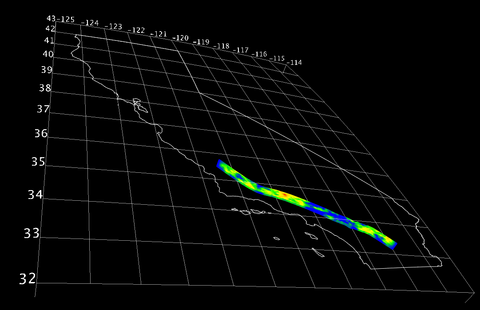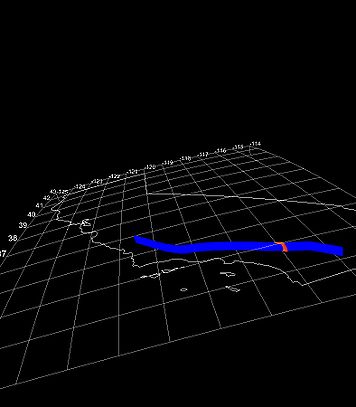Difference between revisions of "CyberShake"
| Line 6: | Line 6: | ||
== Related Work == | == Related Work == | ||
*[[CyberShake Data Web Service - SRF Retrieval]] | *[[CyberShake Data Web Service - SRF Retrieval]] | ||
| + | |||
| + | One of the requirements for the 2010 USEIT intern class was to create a Standard Rupture Format (SRF) browser plugin for SCEC-VDO. This required a tool to retrieve SRF files from the CyberShake database. The 'GETCSSRF' web service was written to allow users to retrieve the SRF files from the CyberShake database. | ||
| + | |||
| + | This web service was written as a Python web.py application. The service takes a set of arguments to select the desired file out of the CyberShake database and returns the contents of the SRF file is found. The service also supports an option to list the set of supported CyberShake Earthquake Rupture Forecast and Rupture Variation Scenario versions. | ||
| + | |||
| + | [[File:Srf_browser.png|480px|thumb|right|Fig 1: SRF Browser Plugin]] | ||
| + | |||
| + | |||
| + | Fig 1. is a snapshot of the SCEC-VDO SRF Browser Plugin displaying a SRF file retrieved with the 'GETCSSRF' service from the CyberShake Database. | ||
| + | |||
| + | A video tutorial of the SRF browser plugin and the underlying SRF retrieval web service in action created by the USEIT interns can be found here: [http://scec.usc.edu/internships/useit/scec-vdo/video1541 SRF Browser Plugin Tutorial] | ||
| + | |||
| + | |||
| + | [[File:UCERF2_M8.jpg|356px|thumb|right|Fig 2: SCEC Intern development SCEC-VDO displaying a UCERF2.0 rupture representative of the M8 rupture. SCEC-VDO animates the CyberShake SRF files showing hypocenter and rupture velocity.]] | ||
Revision as of 07:22, 13 October 2010
CyberShake is a SCEC research Project that is working to develop a physics-based computational approach to probabilistic seismic hazard analysis (PSHA). The CyberShake approach uses full 3D wave propagation simulations to forecast ground motions that will be produced by specific ruptures which is expected to produced significantly more accurate estimates for many sites than commonly used empirical-based ground motion decay attenuation relationships.
CyberShake represents significant research at SCEC and additional information will be posted on this wiki as time permits.
Related Work
One of the requirements for the 2010 USEIT intern class was to create a Standard Rupture Format (SRF) browser plugin for SCEC-VDO. This required a tool to retrieve SRF files from the CyberShake database. The 'GETCSSRF' web service was written to allow users to retrieve the SRF files from the CyberShake database.
This web service was written as a Python web.py application. The service takes a set of arguments to select the desired file out of the CyberShake database and returns the contents of the SRF file is found. The service also supports an option to list the set of supported CyberShake Earthquake Rupture Forecast and Rupture Variation Scenario versions.
Fig 1. is a snapshot of the SCEC-VDO SRF Browser Plugin displaying a SRF file retrieved with the 'GETCSSRF' service from the CyberShake Database.
A video tutorial of the SRF browser plugin and the underlying SRF retrieval web service in action created by the USEIT interns can be found here: SRF Browser Plugin Tutorial

